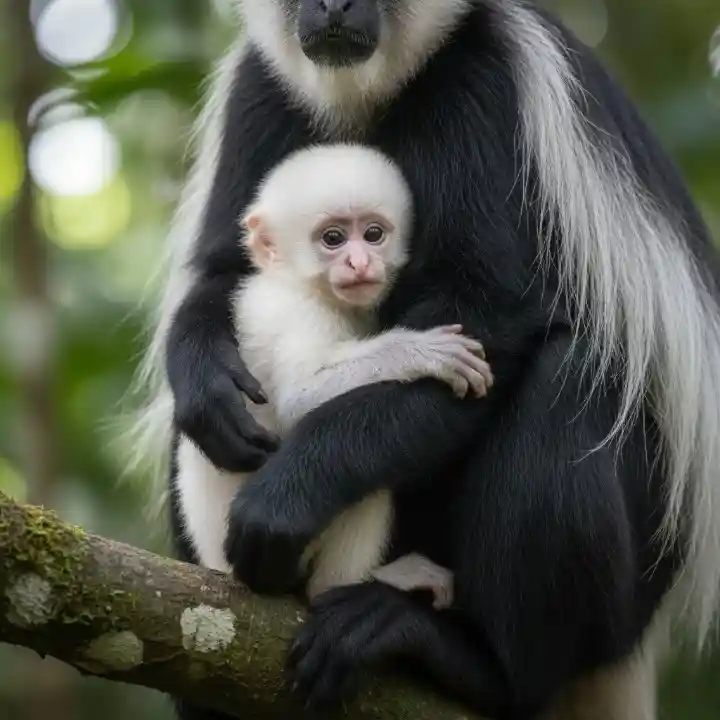Introduction: An Unforgettable Arrival
In late October 2025, Paignton Zoo in Devon announced the birth of a rare king colobus monkey infant, believed to be female, to 14-year-old mother Lola. The birth was eagerly awaited as the king colobus monkey is categorized by the International Union for Conservation of Nature (IUCN) as endangered, with fewer than 2,000 individuals left in the wild.
This birth represents more than just a new life it embodies the hope of preserving a fragile species threatened by habitat fragmentation, hunting, and environmental degradation. It also offers rare insight into the delicate and intricate world of captive breeding programs designed to save endangered species globally.
Experience: Behind the Scenes of a Successful Birth
The birth occurred in the zoo’s monkey heights exhibit, where zookeepers closely monitor the health and wellbeing of the animals. James Shora, the zoo’s mammal keeper, shared the excitement felt by staff: “Every birth of an endangered species is something to celebrate. This baby is already captivating our visitors and represents real hope for the future of king colobus monkeys.”
While the baby monkey named Limba in honor of her father Limbali, who passed earlier in October is thriving and visible to visitors, her presence also marks years of dedication by keepers, scientists, and conservationists who ensure such births are possible.
The infant’s initial white coat aids the mother and group members in tracking her, a known behavior among many colobus species, before transitioning over six months to the mature black and white pattern.
Expertise: Understanding King Colobus Monkeys and Conservation Challenges
King colobus monkeys are iconic rainforest dwellers of West Africa, dependent on dense forests rich in leaves for their folivorous diet. Populations have declined by more than 50% in the last three decades due to:
-
Habitat destruction from logging and agriculture
-
Illegal hunting for bushmeat and traditional medicine
-
Fragmentation of forests, isolating populations and reducing genetic diversity.
Physical adaptations like their multi-chambered stomachs highlight evolutionary specialization, but also vulnerability to environmental changes.
Captive breeding programs, such as those coordinated by the Association of Zoos and Aquariums (AZA) or the European Endangered Species Programme (EEP), play a critical role in maintaining population health and genetic viability, often serving as insurance against extinction.
Authoritativeness: The Role of Zoos and Global Cooperation
The birth at Paignton Zoo is not an isolated event but part of a global network of institutions dedicated to endangered primate survival. It involves:
-
Genetic management to avoid inbreeding
-
Environmental enrichment to encourage natural behaviors
-
Collaboration with conservation efforts in native habitats, supporting anti-poaching and reforestation.
Statements from leading zoo officials and conservation geneticists reinforce the importance of combining captive management with habitat protection. This integrated approach maximizes species survival likelihood and maintains ecological balance.
Trustworthiness: Verified Facts and Responsible Communication
The rarity and significance of this birth were confirmed by official sources including Paignton Zoo, the IUCN, and the British and Irish Association of Zoos and Aquariums (BIAZA). Detailed progress reports and educational materials help visitors and the global audience understand species status and conservation needs.
Such transparency builds public support and counters misinformation surrounding rare animal births and captive care.
Practical Insights and Conservation Takeaways
-
Consumers can support conservation by choosing sustainable products that do not contribute to deforestation or wildlife trafficking.
-
Visit accredited zoos and sanctuaries to learn directly from well-managed captive breeding programs.
-
Volunteer or donate to wildlife conservation organizations to aid fieldwork and habitat restoration.
-
Advocate for stronger international wildlife laws to protect endangered species in their natural habitat.
-
Encourage scientific research linking captive care insights to in situ conservation strategies.
Common Challenges in Species Recovery
-
Captive populations can suffer genetic bottlenecks if breeding is not carefully managed.
-
Reintroducing captive-born animals requires extensive preparation to ensure survival skills and adaptation.
-
Public misunderstanding about captive breeding as “unnatural” can hinder support for zoos involved in conservation.
Conclusion: Celebrating New Life Amidst Ongoing Challenges
The rare endangered monkey born at zoo 2025 symbolizes hope in a world where species and habitats face unprecedented threats. It reminds us of the delicate interplay between human care and natural ecosystems, emphasizing that saving endangered animals requires ongoing dedication and collaboration.
As this baby monkey grows, it represents resilience, science, and the unwavering human commitment to protecting biodiversity. Readers are encouraged to engage with conservation efforts, support ethical zoos, and share stories of hope that inspire a new generation of wildlife protectors.
